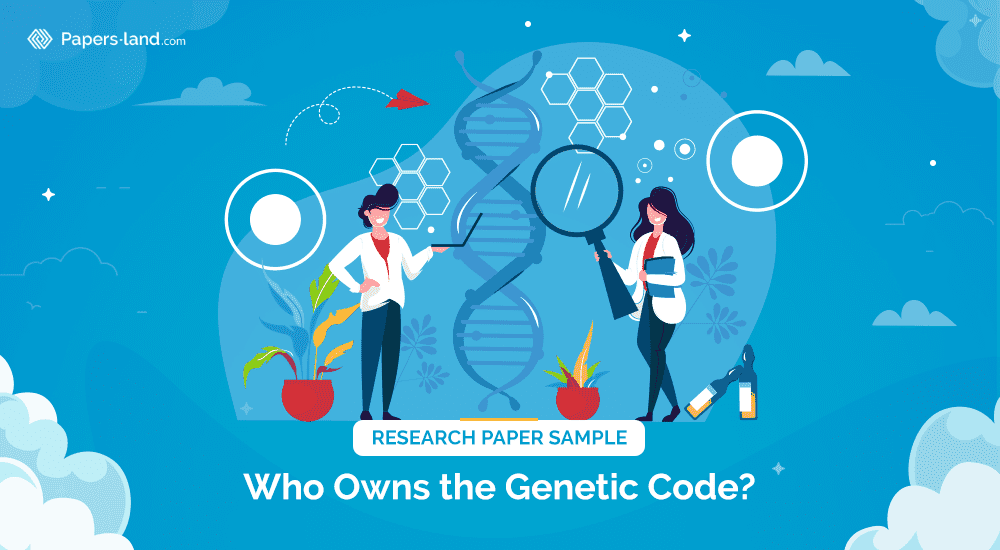


March 19, 2021
Scientific investigations, forced by the human interest, bring their implications to everyday life and open possibilities for further inventions, thus reinforcing scientific progress. The studies, connected with hereditary background, started when Watson and Crick invented the double helix DNA structure and complementarity rules. Since then, numerous scientists have performed their investigations in molecular biology, working on different clues about genetic information and its decoding. While bringing astonishing possibilities for experiments and further inventions, genome investigation has also caused ethical and law problems that are still actively discussed by specialists and the media. Concerning all legal, social, commercial, and scientific issues, questions on how to deal with personal genetic information and who should and could have access to it remain quite relevant.
Calculate the price
The most benchmark-setting project, performed to enrich the knowledge about human genetic information, was the Human Genome Project. In 1990, many scientists were united to work on sequencing the whole human genome by this blue print. The project was supposed to be finished by the end of 2015, but it ended successfully in April 2013, fulfilling even more goals than it was expected at the beginning (National Human Genome Research Institute). First, the idea of sequencing the whole human genome appeared in 1985, but it was not considered a promising one (National Human Genome Research Institute). During the next five years, the project was introduced and planned, while the search for investors and scientist was conducted (National Human Genome Research Institute). The information, gathered during the work on the Human Genome Project, is supposed to be widely disseminated. Therefore, numerous commercial startups and scientific investigations use its results to complete their further investigations and apply them to clinical practice.
However, in addition to the significant amount of important scientific data obtained during the project, several legal and social issues emerged. Consequently, the Human Genome Project developed ethical, legal, and social implications for operating with genetic information, which was received during each investigation, and developed policy options for public consideration (National Human Genome Research Institute ). In 2011, creating the circumstances for a productive and socially regulated research process, the plan was to introduce a cost-effective and highly applicable clinical investigation that would help assess risks and outcomes for the number of diseases for each person individually (National Human Genome Research Institute). The National Human Genome Research Institute states the projects actual strategies such as achieving significant progress, based on the primary research of the structural and general biological features of genomes in discovering diseases nature, and improving medical knowledge in general. Furthermore, such companies as Complete Genomics and Applied Biosystems have intercepted the further development of technological possibilities to make genome sequencing cheaper and faster.
Check out our research paper writing service. Here you can get quality help with your paper!
The process of sequencing genomes started from virus organisms and proceeded to bigger mammals and humans. The first sequencing technique that was used at the beginning of the Human Genome Project was called hierarchical sequencing and was used preferably for eukaryotic organisms (Zhao). At the same time, Zhao compiled a review of several techniques that had been used instead of the classic ones, applied during the Human Genome Project. They are single molecule arrays, 454 genome sequencer, accurate multiplex polony sequencing, a Sanger/Pyrosequencing hybrid approach, nanopore sequencing, and diploid genome reconstruction (Zhao). The reason why the new methods have been developed is the high price and significant amounts of time spent to obtain the results with traditional tools. Hereby, modern genome sequencing technologies are aimed at lowering these two exponents. According to Zhaos investigation, none of the existing techniques is perfect because they have a number of errors occurring during the sequencing process; however, they propose several advantages. The most perspective one is 454 genome sequencer since it successfully solves the problem of paired-end sequencing and the short read length (Zhao). The variety of techniques and projects engaged in improving the quality of genome sequencing represents the importance and a promising outlook of the data that could be acquired, which definitely means that the methods will be improved soon and the technology will get its practical application.
The popular trend in modern genetics technology is suggested by an American start-up company called Complete Genomics, founded in 2006. The Complete Genomics representatives believe that the price of 1,000 dollars for the genome investigation will make it possible to apply it into everyday medical practice (Pollack). They have successfully achieved the transitional goal price of amount 5,000 dollars and then, reached the price of 1,000 dollars (Pollack). When saying about applying this method into practice, the companys executives mean that such a cost would be acceptable to many patients who would want to reveal their genetic predispositions or find the best matching medications.
The aims of further inventions in genomic technologies are aimed at increasing the read length of genomic fragments. The mutation rates, as well as selective forces, influence variant clustering (Sudmant et al. 79). The advances in this technology are made by another company, called Illumina. Thus, it reaches the goal of lowering the price and time by basing the analyses on the processor called 7.4-fold Illumina WGS (Sudmant et al. 80). According to this kind of technological improvement, the read length is increased and the greatest part of the complexity of variations is captured.
While Illumina advanced with improving its equipment, the company from Connecticut, called 454 Life Sciences of Branford, had chosen a different way. Competing with Applied Biosystems on the market of genetic investigation, this company decided to reduce the costs by developing a method that would enable scientists to simplify the sample-preparation procedure (Check Hayden 295). The novelty of the Applied Biosystems method also lies in performing several sequencing reactions at the same time on a solid surface (Check Hayden 295). This technique reduces costs due to a significant decrease of the amount of fluids and enzymes, used to perform the sequencing of each sample.
Nowadays, modern technologies enable scientists to produce the whole genome of one person in around 40 minutes. The goal of the genetic industry companies, which was set five years ago, became real. As an example of such implication, one could consider the study by Ghorashi and Garg. The authors investigated the application of full genome sequencing in the emergency management of genetic diseases, and for this, they used equipment, produced by Illumina (Ghorashi and Garg). The machines allowed to sequence and analyze the genome in 26 hours totally (Ghorashi and Garg). The time reduction depended mostly on the computer hardware capabilities, executing the analysis in 40 minutes instead of hours. The further development of genome findings will depend on the progress in computer science and chemistry.
Being an expensive and complicated investigation not so long ago, genome sequencing quickly becomes available in hospitals and private laboratories as a routine method. Therefore, the spread of genetic information broaches a subject of ethical and deontological issues concerning this kind of data. The DTC tests might lead to life-threatening decisions, based on misunderstanding genetic tests results. This hypothesis has distributed the practice of ordering and providing the results by healthcare specialists (Wendelsdorf). However, Wendelsdorf suggests that is a misconception and the patients reaction to the genome test results would be the same as general blood count or chest X-ray that are full of unclear data and abbreviations. Supporting this suggestion, the author offers the results of the studies, showing that people are not often significantly distressed by the positive results for some inherited diseases mutations in their genome and they do not hurry to interpret them as inevitable outcome (Wendelsdorf). Withholding genetic test results as a kind of personal information is a direct violation of personal rights and freedoms; therefore, every patient should have a free access to it. Since this information is complicated and unclear for patients, most clinics that provide genetic tests propose a consultation of a genetic specialist as part of standard protocol (Wendelsdorf). Consulting the specialist before or after the test, the patient can clarify all points that seem abnormal with a specialist and receive the lifestyle-related recommendations, which would solve the problem of misunderstanding the data.
Another investigator, George Church, also supports the idea of making the whole genome commonly available. However, to perform the investigation, one is required to provide an order from a healthcare specialist (Buhr). This limitation should prevent acquiring the information about individuals genome by the subjects, to whom the tissues under investigation do not belong. As a result, the discriminations, connected with genetic findings, would be prevented. Furthermore, Church believes that whole genome investigation would be the golden standard instead of other genetic tests altogether (Buhr). The main advantage is that the information about possible risks and predispositions of an individual is obtained at once, without waiting for the first pathologic signs of the disease.
The question about who should have access to the genetic information of an individual was first voiced when the Human Genome Project was released. Having raised such a controversial subject, the project was actively discussed by mass media. The amount of information available on this topic was enquired with public interest and claims that genetic information should be accessible to every person. This agiotage seems to be baseless regarding that fact that ones genetic information is just another medical test, the same as a general blood and X-ray tests. Consequently, it is necessary to identify the persons who should and should not get access to genome investigation results.
The person who is highly responsible for the patients health is a family doctor. Such a physician should not disclose their patients personal data or discriminate the person when providing them with medical help according to their test results. This is the rule of medical professional deontology, so it is not necessary to hide the information, obtained from genetic testing, from the patient. The famous geneticist Ann Wojcicki claims that as far as genetic testing becomes more and more accessible every day, people will benefit from discussing their genetic test results with their physicians and will acquire a possibility to improve their health and avoid preventable deaths (Wojcicki). Therefore, the patient does not seem to get any potential harm from the fact their physician has their whole genome testing results; however, it is not obligatory.
Another group of people that would profit from having individuals personal genetic information are scientists. This group of people as well should not spread any data, gained from the persons under the research; therefore, there is no need to be afraid of the information, getting to their hands. However, in case it does, it may bring significant data for further inventions. Specifically, more effective drugs may be produced or their indications may be changed according to genetically revealed regularities. Cancer screening methods for genetically inherited forms of this disease will become unnecessary because the investigation will be included in the whole genome test. New forms of target therapy may be invented and indicated to the certain recipients with better outcomes. The points listed above may be achieved without acquiring access to an individuals genetic data directly. Nevertheless, it would significantly facilitate finding the statistically consequential amount of data that is needed for achieving information validity in a shorter period of time.
However, several ethical aspects of the scientific process still should be considered. It is common for scientists to patent their inventions and to avoid the situations when the genetic data of an individual fall under the copyright of the researcher. The US Supreme Court has declared that patenting naturally occurring DNA is forbidden and it may not be used for cloning aims without special permission of the tissue owner (Timeline: History of Genomics). Cloning and other experiments with human genetic data are forbidden in the USA, which is needed to fulfill human rights and freedoms, but this significantly decelerates the scientific progress in gene engineering.
At the same time, there is an opinion that insurance companies should not get access without patients permission to their genetic testing results. It seems that if they did have this access, the insurance system would have been improved (Klitzman et al. 1856). Nevertheless, patients often voice concerns that this information will lead to an unjustified growth of their insurance payments (Klitzman et al. 1856). Furthermore, Wojcicki suggests permitting the access for insurers to the information about certain genes and variants that are scientifically defined as well-studied, having high frequency of phenotype expression, and statistically significant. Such a solution would decrease the number of people who receive the rejection of insurance payments without underestimating insurers interests (Wojcicki). However, this may work well if the whole genome information is given to insurers in the cases when one seeks to increase their insurance cover. In this case, companies will gain the possibility to account the effective discharge size.
As far as many psychiatric disorders, such as ADHD or schizophrenia, could be identified by using the genome investigation, it is necessary to give permission to access such a genetic information by court practitioners. The Electronic Frontier Foundation team claims there is the growing practice in the USA to collect genetic data from persons when arrested and enter this information into a database for further use by the police or legal representatives. This information may significantly assist in the decision-making in the cases of determining ones dispositive legal capacity. Nevertheless, these data should be used by the court with a high level of exactitude to avoid discrimination and making unsupported decisions.
On the other hand, certain groups of people should not be allowed to get access to individuals genetic information. Thus, privacy protection is regulated by HIPPA and GINA rules. According to the title II of GINA, it is strictly prohibited to use genetic information to discriminate in employment decisions, housing, provision of emergency services, education, mortgage lending and elections (Electronic Frontier Foundation). Therefore, non-medical and non-legal representatives in the issues that do not pertain to ones health should not get access to the genome testing results. This may influence their decisions in the cases that do not concern health care.
Investigating human genome has made a great progress in medical, biological, and chemical sciences. At the same time, the inventions have identified several ethical and legal issues to be solved. Altogether, ones genetic information should be treated as any other medical test data. Being represented by the complicated information and numerous abbreviations, the results of genetic testing should be discussed with the physician or genetic specialist to achieve the patients maximal understanding of the significance of these results. Furthermore, one can acquire a direct recommendation to their possible lifestyle modifications to avoid the advance of the diseases or pathologic conditions. Whole genome data should be also available to scientists to assist the progress in pharmaceutical science and gene engineering to provide more specified ways to treat oncologic and inherited diseases. The access to genetic information by insurers and court representatives would advance public health and social safety. To avoid the discrimination based on the genetic data research, the results of genetic testing, which are highly accessible nowadays, should be protected from the persons, to who they do not concern, by privacy policies. The possibility to obtain ones whole genome in a fast and affordable way opens numerous advantages for the individual to achieve the maximal expression of their health potential.